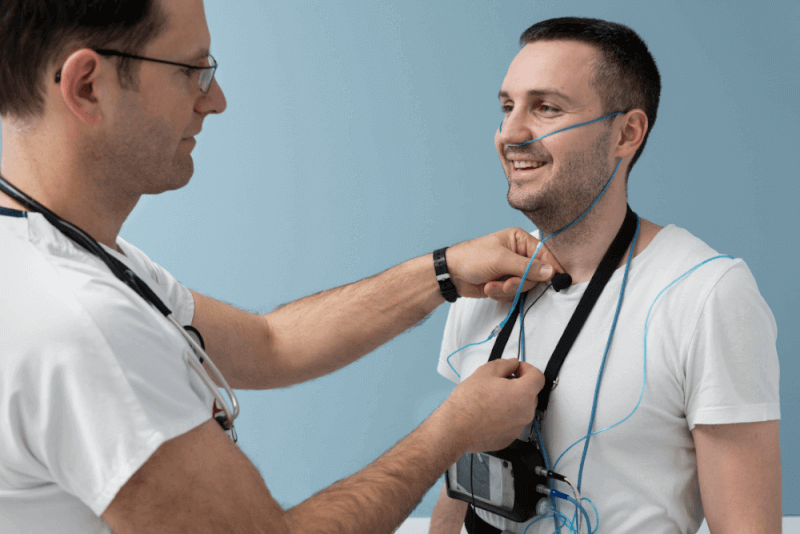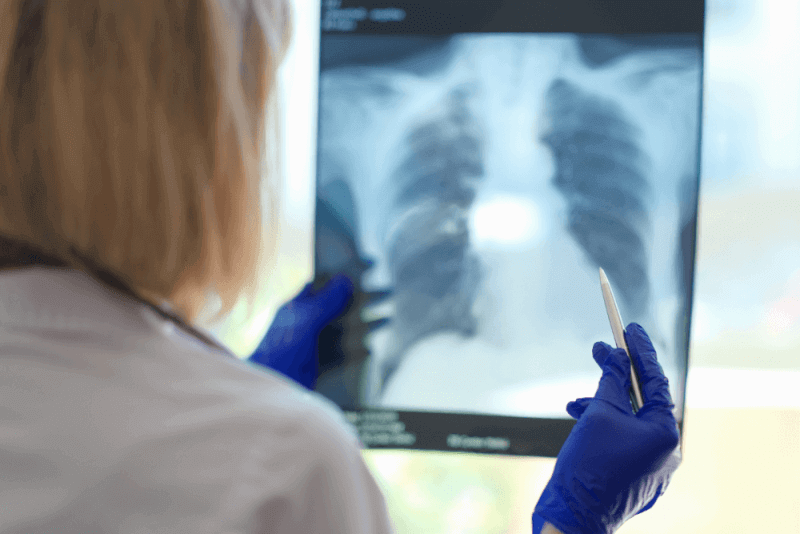What is a Pulmonary Function Test (PFT)?
Pulmonary function tests, which measure how well air is exchanged in the lungs, include various types of tests. Some types also measure how well oxygen is absorbed into the blood and how exercise affects the lungs. These tests do not require any device or sensor to be placed inside the body.
Types of Pulmonary Function Tests
Types of pulmonary function tests include:
Spirometry
Spirometry measures how much air can be inhaled and exhaled. It also measures how much air is in the lungs.
Lung Volume or Body Plethysmography
This test measures the various amounts of air in the lungs after different inhalation and exhalation points.
Gas Diffusion Test
This test measures how much oxygen and other gases pass from the lungs into the blood.
Cardiopulmonary Exercise Test
This test measures how well the heart, lungs, and muscles work during exercise.
Respiratory Muscle Pressures
This test evaluates the strength of respiratory muscles using maximal inspiratory pressure and maximal expiratory pressure. It determines the strength of the diaphragm and other breathing muscles.
Bronchoprovocation Test
This test assesses airway sensitivity. Pharmacological and exercise challenge tests are the most commonly used methods for the accurate diagnosis of asthma.
Why is a Pulmonary Function Test (PFT) Done?
Pulmonary function tests are conducted if there are symptoms indicating lung problems, such as cough or shortness of breath. They may also be requested before surgery or if there is a history of tobacco use. Conditions that suggest the presence of lung problems include:
- Feeling of tightness, pain, or pressure in the chest
- Cough
- Cough producing mucus or phlegm
- Difficulty breathing
- Difficulty taking deep breaths
- Shortness of breath
- Wheezing
In some cases, even if symptoms are not present, pulmonary function tests may be requested as part of a physical examination.
Pulmonary function tests help doctors with the following:
- Determining if there is narrowing of the airways
- Detecting early changes in the ability to transfer oxygen from the lungs to the blood
- Measuring the impact of continued smoking on chronic lung diseases
- Assessing if the treatment is effective
- Understanding if environmental exposures are affecting the lungs
- Determining the ability to tolerate surgery or other medical procedures
How is a Pulmonary Function Test (PFT) Done?
To prepare for a pulmonary function test, the following should be considered:
- Stopping the use of respiratory devices for a short period
- Wearing loose and comfortable clothing
- Avoiding heavy exercise before the test
- Not using tobacco products before the test
- Avoiding heavy meals
- Not consuming caffeine
Paying attention to these points ensures the most accurate results in pulmonary function tests.
Before starting the test, some personal information needs to be taken, including:
- Height
- Weight
- Age
- Race
- Gender
These demographic details are taken to ensure accurate measurements and to determine normal value ranges. After entering this information into the device, the instructions given to the patients vary according to the test applied.
Spirometry
For the spirometry test, clips are placed on the patient's nose to ensure breathing through the mouth. Then, a mouthpiece is placed between the lips and connected to the spirometry device. The patient follows the instructions given by the specialist.
During the test, deep breathing and blowing as hard and fast as possible may be required.
Body Plethysmography
In this test, nose clips are first placed. Then, the patient sits inside a transparent box. The door is closed for about five minutes. Therefore, individuals with claustrophobia should inform their doctor.
Next, the lips are placed around a mouthpiece, and instructions on how to breathe are given. The spirometer detects pressure and volume changes in the box during breathing to help measure lung volume.
Gas Diffusion Test
In this test, nose clips are again used. Safe amounts of carbon dioxide gas are given to the patient through a mouthpiece, and instructions on how to breathe are provided. The spirometer measures the amount of carbon monoxide exhaled during breathing, indicating how much gas the lungs absorb.
Cardiopulmonary Exercise Test
After attaching sensors from machines that measure heart rate, blood pressure, and blood oxygen levels to the patients, they start walking on a treadmill or pedaling on a stationary bike. The function of the muscles, lungs, and heart is examined from various perspectives during the activity.
Pulse Oximetry Test
This test measures the amount of oxygen in the blood. A probe is attached to one of the fingers, the earlobe, or another area of the skin. The probe measures the oxygen levels in the red blood cells.
Arterial Blood Gas Test
This is a blood test that measures the amount of oxygen and carbon dioxide gases in the arterial blood.
Fractional Exhaled Nitric Oxide Test
In some types of asthma, the level of nitric oxide in the body can increase. For this test, a tube connected to a portable device is used to breathe in and out slowly and regularly.
Lung Volume Measurement Test
There are two different tests that measure lung volume. One is plethysmography, and the other is the gas dilution method. In the gas dilution method, also called nitrogen washout and inert gas dilution, inert gases like nitrogen or helium are used. The patient breathes in and out until balance is achieved, and then lung volume is measured.
What Can Be Diagnosed with a Pulmonary Function Test (PFT)?
Pulmonary function tests can diagnose the following conditions:
- Asthma
- Allergies
- Chronic bronchitis
- COPD
- Damaged or scarred lung tissue
- Disease caused by inhalation of asbestos fibers
- Sarcoidosis
- Lung cancer
- Infections
- Thickened, stretched, or widened airways
- Thickening or hardening of connective tissues
- Weakness of the chest wall muscles
What Do Pulmonary Function Test (PFT) Results Mean?
Pulmonary function tests provide many different data points. The most commonly used data include:
Spirometry
The spirometry test helps diagnose common respiratory problems. The data obtained from this test include:
- Forced Vital Capacity (FVC)
- Forced Expiratory Volume in the first second (FEV1) and the FEV1/FVC ratio
- The FEV1/FVC ratio should be greater than 0.70
- Both FEV1 and FVC values should be above 80%
Lung Volume
The lung volume test measures several important values, including:
- Functional Residual Capacity (FRC)
- Vital Capacity (VC)
- Slow Vital Capacity (SVC)
- Expiratory Reserve Volume (ERV)
- Residual Volume (RV)
- The sum of RV, VC, or FRC with Inspiratory Capacity (IC) is the gold standard for diagnosing restrictive lung disease. This value, known as TLC, should be above 80%. If it is below this level, a restrictive respiratory disorder is diagnosed.
Diffusion Capacity
The DLCO value, or Diffusing Capacity of the Lung for Carbon Monoxide, is measured in this test. A high value may indicate asthma, obesity, or intrapulmonary hemorrhage. A low value, along with normal spirometry and lung volumes, may indicate pulmonary vascular diseases, early ILD, or emphysema. A diffusion value above 75% is considered normal.
Respiratory Muscle Pressures
This test measures respiratory muscle strength, including:
- Maximal Inspiratory Pressure (MIP) should not be less than -90 cm H2O in adult males and -70 cm H2O in females. For adults over 65 years, the minimum value for males is -65 cm H2O, while for females, it is -4 cm H2O.
- Maximal Expiratory Pressure (MEP) should not exceed 140 cm H2O in adult males and 90 cm H2O in females. For adults over 65 years, the highest value for males is 90 cm H2O, and for females, it is 60 cm H2O.
Walk Test
In adults, a clinically significant minimum difference for the 6 MWT distance is 30 meters.








